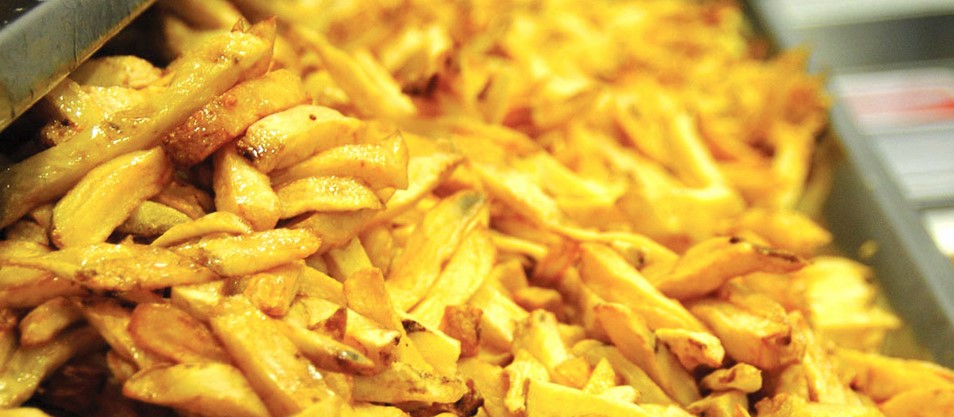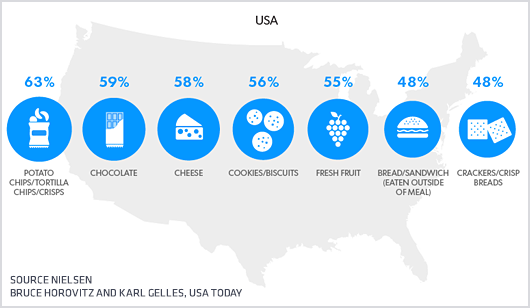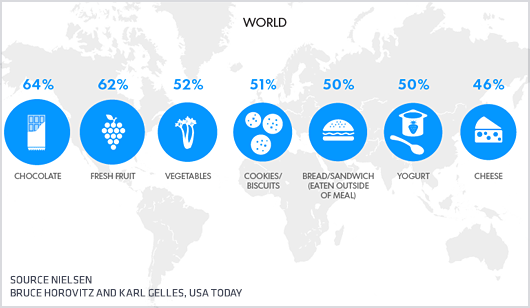Franchising, retail, business

05/10/2014
Krystian Nawrocki | Getty Images
The snack is nibbling away at how the world eats, drinks and lives.
While Americans snack a bit differently from the rest of the world, with a special penchant for chips, the simple snack — from a candy bar to a piece of fruit to a granola bar — now permeates the globe as it increasingly replaces breakfast, lunch and dinner in households from Houston to Hanoi.
That's the conclusion of an exhaustive study due out Monday by consumer research giant Nielsen. Its Nielsen Global Survey of Snacking polled online more than 30,000 consumers in 60 countries between mid-February and mid-March of 2014. Snacking, the study estimates, has evolved into a $374 billion global industry — and is growing about 2% annually, which is a considerable amount in a shaky, global economy.
More from USA Today:
Comic Con to kick off with limited-edition Batman stamp
Trial over AIG bailout set to open Monday
Factory construction boosts economy
The impact of the snacking boom will be huge, affecting the way companies make, market and serve food, and it will influence the kinds of food products that food makers concoct going forward, the study concludes.
"Snacking connects consumers globally," says James Russo, senior vice president at Nielsen. Consider: 91% of consumers polled say they snack at least once a day. And 21% are snacking three to four times daily — the majority being women.
But snacking is no longer just about satisfying a sweet tooth or hunger pang between meals, but increasingly about substituting them for the meals themselves.
"How we snack as a society is changing," says Russo. "Snacks are increasingly meal replacements."
Some 45% of consumers, globally, says the use snacks as meal replacements. Roughly 52% same they sometimes replace breakfast with a snack; 43% replace lunch with a snack and 40% replace dinner with one.
Breakfast was the most common meal to be replaced with a snack. Some 55% of Asians surveyed say they replace breakfast with a snack — followed by 49% of North Americans and 44% of Europeans.
"Any way you slice it, these are big numbers," says Russo. "Consumers are re-defining how we eat around meals. If I'm a big food company, I have to think about how to make, market or re-purpose products to a consumer who wants to eat on the go, and is using snacks as meals."
But it's what we Americans are snacking — or not — that's particularly interesting.
First off, we're chip-a-holics. There is nothing we snack on more than chips of all sorts — from potato to tortilla. Some 63% of Americans surveyed said they'd snacked on some sort of chips within the past 30 days. Chocolate — mostly in the form of candy bars — ranks second. And cheese snacks finish a close third.
But the rest of the world appears to snack a tad healthier than we do. Globally, the top snack is chocolate. Some 64% of consumers surveyed globally said they had a chocolate snack within the past 30 days. Fruit ranked a very close second. And vegetables ranked third. 
The top snack for Europeans is fruit, followed closely by chocolate and cheese.
Much of this can all be explained by the wildly different attributes that various cultures crave in snacks. The top attribute that Americans seek is "salty and savory" snacks. But globally, consumers opt for "crispy" — which is why so many chocolate bars are crispy.
Snacking isn't just a fad or trend — it's the future, says Russo. "Big as snacking is today, it's only going to get bigger."